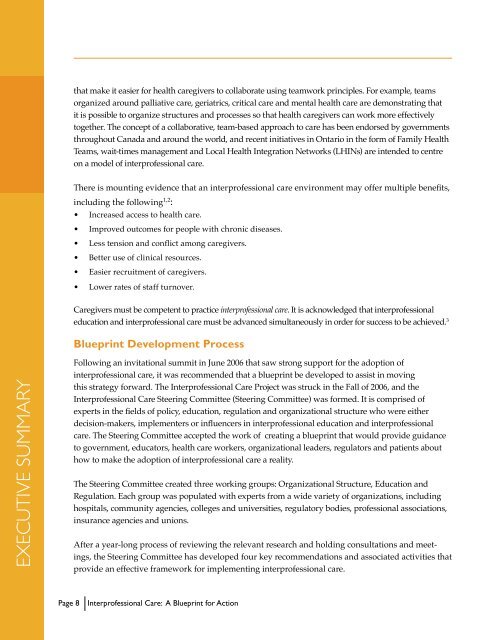Interprofessional Care: A Blueprint for Action - HealthForceOntario
Interprofessional Care: A Blueprint for Action - HealthForceOntario
Interprofessional Care: A Blueprint for Action - HealthForceOntario
You also want an ePaper? Increase the reach of your titles
YUMPU automatically turns print PDFs into web optimized ePapers that Google loves.
EXECUTIVE SUMMARY<br />
that make it easier <strong>for</strong> health caregivers to collaborate using teamwork principles. For example, teams<br />
organized around palliative care, geriatrics, critical care and mental health care are demonstrating that<br />
it is possible to organize structures and processes so that health caregivers can work more effectively<br />
together. The concept of a collaborative, team-based approach to care has been endorsed by governments<br />
throughout Canada and around the world, and recent initiatives in Ontario in the <strong>for</strong>m of Family Health<br />
Teams, wait-times management and Local Health Integration Networks (LHINs) are intended to centre<br />
on a model of interprofessional care.<br />
There is mounting evidence that an interprofessional care environment may offer multiple benefits,<br />
including the following 1,2 :<br />
•<br />
•<br />
•<br />
•<br />
•<br />
•<br />
Increased access to health care.<br />
Improved outcomes <strong>for</strong> people with chronic diseases.<br />
Less tension and conflict among caregivers.<br />
Better use of clinical resources.<br />
Easier recruitment of caregivers.<br />
Lower rates of staff turnover.<br />
<strong>Care</strong>givers must be competent to practice interprofessional care. It is acknowledged that interprofessional<br />
education and interprofessional care must be advanced simultaneously in order <strong>for</strong> success to be achieved. 3<br />
<strong>Blueprint</strong> Development Process<br />
Following an invitational summit in June 2006 that saw strong support <strong>for</strong> the adoption of<br />
interprofessional care, it was recommended that a blueprint be developed to assist in moving<br />
this strategy <strong>for</strong>ward. The <strong>Interprofessional</strong> <strong>Care</strong> Project was struck in the Fall of 2006, and the<br />
<strong>Interprofessional</strong> <strong>Care</strong> Steering Committee (Steering Committee) was <strong>for</strong>med. It is comprised of<br />
experts in the fields of policy, education, regulation and organizational structure who were either<br />
decision-makers, implementers or influencers in interprofessional education and interprofessional<br />
care. The Steering Committee accepted the work of creating a blueprint that would provide guidance<br />
to government, educators, health care workers, organizational leaders, regulators and patients about<br />
how to make the adoption of interprofessional care a reality.<br />
The Steering Committee created three working groups: Organizational Structure, Education and<br />
Regulation. Each group was populated with experts from a wide variety of organizations, including<br />
hospitals, community agencies, colleges and universities, regulatory bodies, professional associations,<br />
insurance agencies and unions.<br />
After a year-long process of reviewing the relevant research and holding consultations and meetings,<br />
the Steering Committee has developed four key recommendations and associated activities that<br />
provide an effective framework <strong>for</strong> implementing interprofessional care.<br />
Page 8 <strong>Interprofessional</strong> <strong>Care</strong>: A <strong>Blueprint</strong> <strong>for</strong> <strong>Action</strong>





